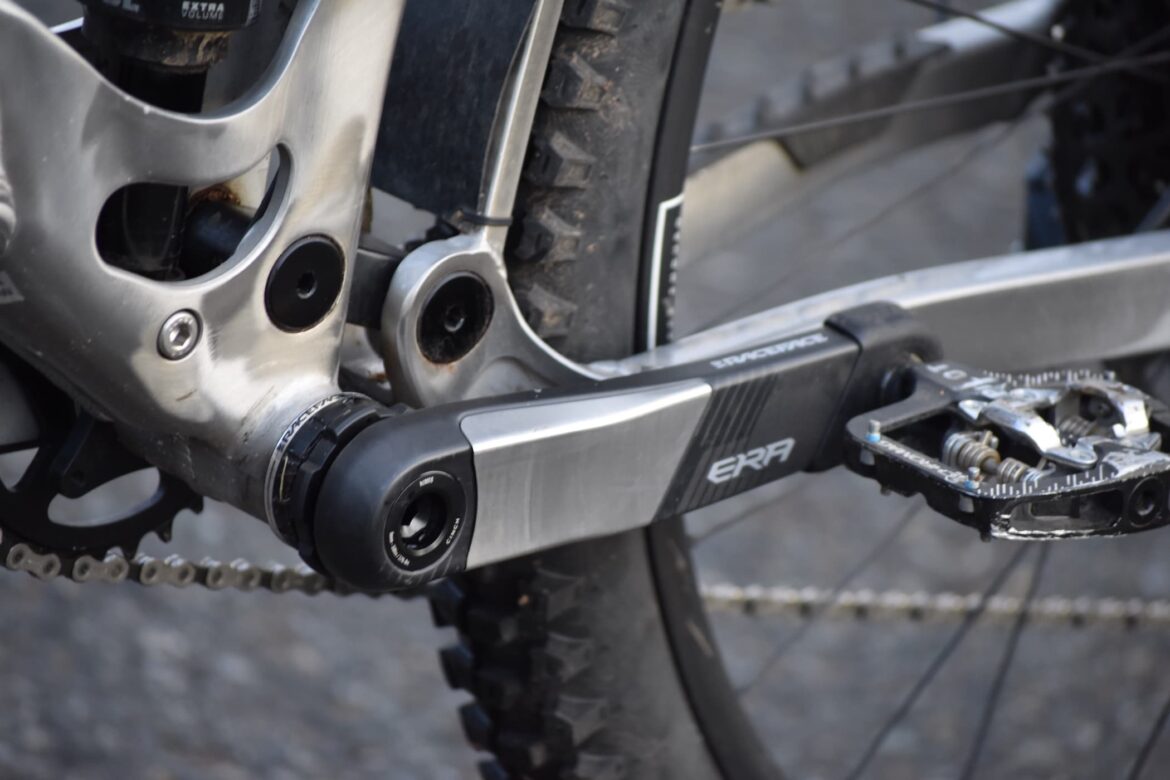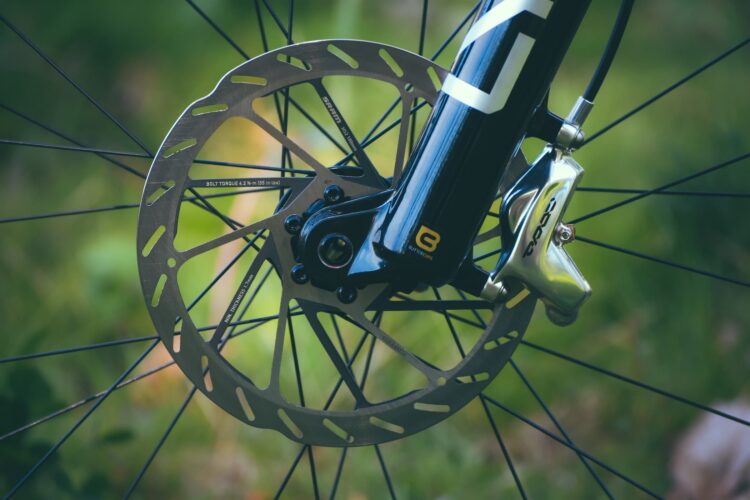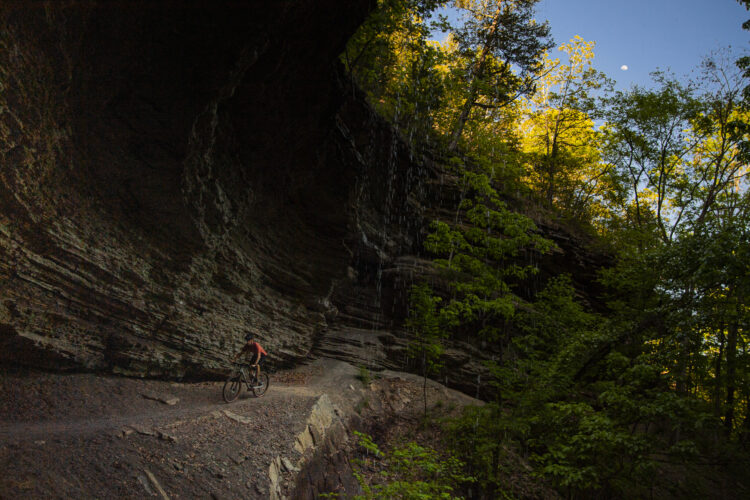The latest Race Face carbon crankset represents a new era in the company’s history, hence the name. The brand says that the Era is the stiffest, strongest cranks that they’ve ever made, and even from an aesthetic perspective it marks a clear departure from previous iterations of Race Face cranks. But the beauty of the Era cranks isn’t just skin deep.

Race Face Era crank specs
Race Face engineers say that they came up with a whole new manufacturing process for the Era cranks, though they’re pretty tight-lipped on what that actually involves, short of saying that the pedal inserts are “bonded directly to the carbon layup.” This inspires confidence given that it’s no secret the Next and Next R cranks had problems with pedal inserts coming loose. Whatever this new process involves, it creates a crank that claims to be better in every measurable way.
One easily measurable metric is weight — the Era claims to weigh 483g versus 493g for the old Next R and 595g for the comparable aluminum Turbine crankset including spindle, chainring, washers, and spacers.
Designed for the trail and enduro crowd, the Era cranks should be able to take a beating; the first noticeable feature is the new stainless steel scuff plate molded into the arm to prevent wear from heel rub. Race Face is now offering a lifetime “no questions asked” warranty, so if you break a pedal insert loose or snap a crank arm in half tomahawking your bike into the ground, you’re covered.
The Era cranks feature a couple of smart features that we already know well such as the 30mm Cinch standard, which enables modular crank spindles and direct mount chainrings. Race Face make a spindle for pretty much every BB width so they’ll fit anything from XC whips to fat bikes, and allow the user to switch the spindle out to suit a new frame. Direct mount chainrings open up options for every popular drivetrain standard in every imaginable size, and make for easy replacement with aftermarket options while keeping weight down.
Retailing at $499, Era Cranks come in three lengths: 165mm, 170mm, and 175mm. They’re available in seven color options and currently are only specced with the 136mm spindle which works for the common Boost standard. Five additional spindle lengths are available separately for pretty much every frame standard. Crank arms and spindle, pedal boots, pedal washers and a small tool for removing the self-extracting bolt are included in the box. Chainring and bottom bracket are not included but there are many options from either Race Face or other manufacturers depending what you want.

Race Face Era setup
Setup of the Era cranks was easy. Using a Race Face BSA 30mm bottom bracket for a 73mm BB shell I simply used the supplied guide included to ensure all spacers were in the correct place and the cranks slotted into place nicely. The supplied diagram is key because it’s not entirely intuitive where the spacers should go at first but the exploded view is helpfully color-coded. The direct mount chainring was easy to fit with an old splined BB tool and a vice, and a torque wrench with 8mm hex bit was all that was needed to fasten the cranks together. The Era uses a redesigned preload collar with a more chunky design that’s easier to turn by hand to achieve the desired preload and with a bigger 3mm hex head bolt that’s much easier to snug up and less likely to get filled with dirt.

Riding the Race Face Era cranks
Up to a certain point, cranks are cranks and they shouldn’t demand much attention unless something is badly wrong, simply going about their job without a second thought. The same is true of the Era cranks; with few modern cranks falling short of the desired stiffness properties of most riders, only the most noodly cranks leave an impression, and the Era are more than adequate. I was never left wanting more, nor was I wowed by their unparalleled stiffness properties, likely because I’m not calibrated finely enough to notice the difference. They simply do their job and that’s all I can really ask. Having spent a few months riding these cranks nothing broke, nothing came loose and I rarely gave them another thought.
One thing that the test period did uncover is that the Era cranks wear pretty well compared to others. I’m a prolific heel-rubber and, despite my initial reservations, the stainless scuff-plate does its job well, warding off the worst of the rub and keeping the cranks looking tidy. The supplied boots also do their job well and absorbed a few impacts while in my care. After a muddy test period, the Era cranks looked almost as fresh as they did the day I got them, and thanks to the finish they clean up easily too.

Pros and cons of the Race Face Era cranks
Pros
- Durable
- Relatively light
- High modularity and compatibility
Cons
- Expensive
Bottom line
The Era cranks are not cheap, but with Race Face’s new lifetime warranty, that makes the idea of a pricey carbon crank more bearable. The attention to detail in future-proofing the crank with swappable axles and direct mount chainrings means short of some unforeseen revolution in cranks, it should be a crankset for life.
Even without relying on that warranty, the Era cranks have been reliable and worn well, promising a new benchmark in strength and dependability for carbon cranks from this iconic Canadian components manufacturer. For those building a bike with the best possible spec, looking for strength and durability without the weight penalty, the Era crank is well worth a look. And hey, they’re still cheaper than titanium.
- Price: $499 (chainring and bottom bracket sold separately)
- Buy from JensonUSA and The Pro’s Closet.






I hope they ditched the plastic preload collar that was a cheapshot move in previous iterations.
Annnnnd, the Walmart NEXT name on their products!!
It’s tricky to see in the photos but I did mention that they have ditched that old preload collar. The new one is still plastic but seems much better made and much easier to use.
Doh! Thanks for the write up, Sam!
Now, if Sunday’s as nice as it was today… One or more of my bikes wanna take me hurtling down a singltrack!
At least the Cane Creek collars are compatible with the Turbines.